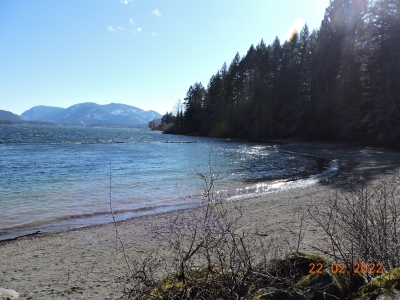North in the Spring # 21:
Cowichan Valley Part 2. by John Neville
Taking Highway #18, we headed up the Cowichan Valley towards the mountains and Cowichan Lake. On a warm day Bald Eagle, Red-tailed Hawk and Turkey Vulture ride the thermals up above. This particular February day was sunny, but arctic winds were blowing across the Salish Sea! Signs cautioned us to lookout for Elk, but none were to be seen. At the town of Cowichan Lake we followed the left fork around the south side of the lake. At a T-junction we turned right, if you turn left you can follow the Pacific Marine Circle tour to Port Renfrew, Sooke etc.(see the fall issue of this publication 2020 Big Lonely Doug). After passing several small communities we reached Gordon Bay Provincial Park. It has an attractive sandy beach and boat launch and trails into the forest. The campsites are nestled amongst the trees. Some of the trees to look for in this area are Western Red Cedar, Sitka Spruce, Western Hemlock and Big leaf Maple. There are clear views to the snow clad mountains all around! When salmon reach the lake they spawn in the Robertson River and other nearby creeks.
 Back at the town site we read the noticeboards listing the names of animals and plants around Cowichan Lake and some of its history. The Weir was nearby, which controls the outflow of water from the lake into the Cowichan River. It is particularly important when the summer droughts cause the river to be too shallow for the returning Coho, Chinook and Chum salmon. Descending back down the valley we took the Cowichan River Road which closely followed the river. At Cowichan River Provincial Park we walked a rough but short trail to Marie Canyon. The river is closely confined and roars down a series of rapids! "...rivers are the veins of the earth through which the lifeblood returns to the heart." Roderick Haig-Brown Our final destination was the Cowichan estuary to the east of Highway #1. There are still rich wetlands in the lowland approaching the sea. However, quite a lot of the land has been diked for housing and industrial activity. The Koksilah River joins the Cowichan before flowing into the bay. One of the access points to the shore is at Hecate Park. A ship called the Hecate arrived in the estuary in1862 and landed a number of European settlers. CoincidentaIIy, that same year one of the worst Smallpox epidemics swept through the First Nations of BC: reducing their population by at least 30%. Marine life in the estuary was a source of food for the local people for millennia. One of the key reasons for the abundance is the up welling of cold ocean currents meeting nutrient rich fresh water from the river. A few of the critters found in the inter tidal area are: algae, plankton, rock weeds, clams, limpids and barnacles. Barnacles are crustaceans like crabs and shrimp. They are hermaphrodite, both sexes being present in each individual. Barnacle larvae are part of the food chain for Herring, and the Herring in turn are eaten by salmon and other larger fish. Beyond the tide line Eel grass provides food and shelter for many species.  Under rocks tiny octopi hide. We once witnessed a adult Giant Pacific Octopus swimming across a large tank. At that moment it was in a translucent form and very difficult for any enemy to see. Then it settled onto a crab and used its beak to penetrate the shell. Over a four hour period it sucked out all the crabmeat. While engaged in its meal it changed its appearance to various shades of brown exactly matching the surrounding sand. The Giant Pacific Octopus has the most highly developed brain of all invertebrates and despite its large size, is a shy retiring animal. A channel called Sansun Narrows separates the Cowichan estuary from SaIt Spring Island. From time to time animals swim across to the island. In the summer and winter of 2021 a Roosevelt EIk was appreciated browsing his way through the woods of Salt Spring. The City of Duncan, the town of Cowichan Lake, the industrial development along the sea-shore and the highway system initially made my understanding of the geography and natural history of this area difficult to comprehend. My sincere thanks to the input of members of the Cowichan Valley Naturalists Society especially Genevieve Singleton and Bruce Coates for their help and pride in the area. |